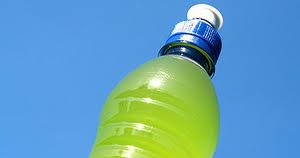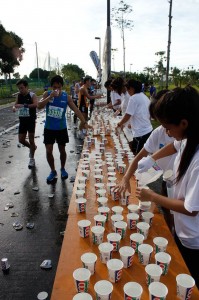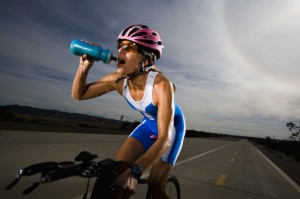 I was recently asked if there are certain sports drinks that I prefer over others. There are actually several sports drinks that I like, use, and recommend, depending on the type, duration, and intensity of training, environmental conditions, and individual considerations for each athlete. It seems like there are new products coming out every month, so those mentioned here are by no means the only ones that I have an opinion about. They just represent a sampling of what’s out there.
I was recently asked if there are certain sports drinks that I prefer over others. There are actually several sports drinks that I like, use, and recommend, depending on the type, duration, and intensity of training, environmental conditions, and individual considerations for each athlete. It seems like there are new products coming out every month, so those mentioned here are by no means the only ones that I have an opinion about. They just represent a sampling of what’s out there.
The main objectives for sports drinks during exercise are supplying adequate hydration, fuel (carbohydrate is the preferred fuel for exercise), and electrolytes (sodium is most important). For exercise lasting 60 minutes or less water alone is usually adequate for hydration. For endurance training and events lasting > 90 minutes (or 60 minutes if high intensity) supplying carbohydrates for fuel and replacing sodium lost in sweat can help prevent cramping and enhance performance. (see “Electrolytes Can Charge Athletic Performance”).
If I’m not going to be eating while training, I will definitely choose something like Gatorade, Powerade, Cytomax, Fluid, etc. that contains carbs to to keep me fueled. My goal is to consume 30-60 gm carbohydrates per hour, and enough fluid and electrolytes to replace what is lost in sweat. A 24 oz. bottle of sports drink (6%-8% carbohydrate) contains about 42 gm. of carbohydrate – perfect!
The concentration and type of carbs in a sports drink have purpose. Research has repeatedly shown that a carbohydrate concentration between 6% and 8% is optimal for rapid absorption and can actually enhance fluid and electrolyte absorption . Carbohydrate concentrations above 8% can inhibit absorption, and may actually draw fluids into the gut, causing one to “slosh” or become nauseous. Anything less than 6% carbs, and you lose an opportunity to fuel. Some sports drinks suggest mixing “one hour” or “two hour” bottles of varying concentrations (based on weight of the athlete). I would recommend caution with this because while fuel needs may vary with the size of the athletes, the gut’s tolerance to high carbohydrate loads does not. A concentrated sports drink (2 hr bottle) can have negative affects unless you drink alternatively between it and plain water….but if you’re going to do that, why not just have 2 appropriately diluted bottles of sports drink?
 The types of carbs found in sports drinks has also been a source of much sports nutrition research. Studies have shown that when there are 2-3 types of carbs comprising the recommended total amount, they are more readily absorbed than a single type of carb would be. Different types of carbs are absorbed in different ways, so can in effect be absorbed simultaneously. This is why sports drinks often contain several different kinds of carbs (or sugars) – the total grams of carbs is not higher because of this, but the energy-rich carbs are absorbed and available to our working muscles and brain sooner than if only one type of carb were used. So don’t freak if the first 3 ingredients of a sports drink are sugars – it’s intentional to enhance absorption and performance.
The types of carbs found in sports drinks has also been a source of much sports nutrition research. Studies have shown that when there are 2-3 types of carbs comprising the recommended total amount, they are more readily absorbed than a single type of carb would be. Different types of carbs are absorbed in different ways, so can in effect be absorbed simultaneously. This is why sports drinks often contain several different kinds of carbs (or sugars) – the total grams of carbs is not higher because of this, but the energy-rich carbs are absorbed and available to our working muscles and brain sooner than if only one type of carb were used. So don’t freak if the first 3 ingredients of a sports drink are sugars – it’s intentional to enhance absorption and performance.
For long training or event days (3+ hours) I find that a sports drink with a little protein (or amino acids) like Accelerade seems to sustain me better (and the research supports this). However, some athletes don’t tolerate products like this very well or may find the taste objectionable. Proteins (and amino acids) do have a sustained release effect for energy but are not as readily available for fuel as carbohydrates, so adding them to a carbohydrate containing sports drink makes sense. Consuming something higher in protein than in carbs does not.
If I know I will be eating during training (as is often the case with cycling or hiking), I often choose nuun. I love nuun because it’s not overly sweet and it’s convenient to carry…but it contains only electrolytes, so I have to get my carbs (i.e. fuel) from some other source when I use it. One advantage of nuun is that because it has no sugars in it, it can be used in a hydration pack without gumming it up. When cycling I usually have one bottle with a carb-containing sports drink, and one with nuun (carb-free) or water. I drink from the carb-free bottle after eating food or sports gels. It is important to keep in mind if you use sports gels, blocks, beans, etc. that these products are intended to be consumed along with water. If not, the concentration of carbs in the gut may be too high, causing discomfort or even diarrhea (ever hear of “runners trots”). For this reason, it is wise during running events to plan to consume sport gels, etc. when approaching a hydration station.
If it is hot and/or humid, I opt for something with a higher sodium content; I prefer EFS, but several products, including Gatorade Endurance and Power Bar’s Ironman Performance are comparable – it’s a matter of individual taste preference and tolerance. Hammer products like Heed and Perpetuem have adequate carbs (if mixed 2 scoops per 24 ounce bottle), but are low in sodium so need to be supplemented with a sodium source if used. (I’ve wondered if this may be intentional because Hammer promotes taking their electrolyte supplement Endurolytes as a separate product?) Some athletes I work with mix Heed and nunn together in one bottle for a compliment of carbs and electrolytes – that works well too  Many sports gels, blocks, etc, can supply the sodium…so can pretzels or other salty foods. You can mix and match food and beverages in a variety of ways to accomplish adequate fuel, hydration and electrolytes.
Many sports gels, blocks, etc, can supply the sodium…so can pretzels or other salty foods. You can mix and match food and beverages in a variety of ways to accomplish adequate fuel, hydration and electrolytes. For conditions with more extreme heat and/or humidity where sweat rates and sodium losses are high, the electrolyte drink TheRight Stuff which has a very high sodium content can be a good choice. I don’t generally use this product in the relatively cool conditions where I train in the Pacific Northwest, but it was exactly what I needed during El Tour de Tucson when riding through the desert for 100+ miles.
For conditions with more extreme heat and/or humidity where sweat rates and sodium losses are high, the electrolyte drink TheRight Stuff which has a very high sodium content can be a good choice. I don’t generally use this product in the relatively cool conditions where I train in the Pacific Northwest, but it was exactly what I needed during El Tour de Tucson when riding through the desert for 100+ miles.
As a sports dietitian, I find that personal preferences and tolerances can be big factors when choosing a sports drink. Some products simply aren’t well tolerated by some athletes, but work fine for others..same goes for flavors. There are many ways to get the recommended fluids, fuel (carbs) and sodium, so I encourage athletes to experiment with various products, foods, and combinations therein to find what works best for them…and to practice with whatever they plan to use on event day. It’s convenient to use products provided by event organizers, so I recommend finding out ahead of time what those products will be and to train using these products to make sure they are well-tolerated. Race day is no time to try out a new sports drink, new shoes, or a new bike saddle  There really is no one best product or combination of foods. It is best to experiment a bit and discover what works best for you…and it may not be what works best for your workout buddy. Just like running shoes, bike saddles and wet suits… sports drinks will ‘fit’ various athletes differently. You will likely have to try a few options before you find the best fit for your hydration & fueling needs. The important thing is that you do hydrate and fuel for your workouts…however you choose to do it….your performance will reflect your efforts. Good fuel and hydration strategies can give you more energy and keep you going longer. Who doesn’t want that??
There really is no one best product or combination of foods. It is best to experiment a bit and discover what works best for you…and it may not be what works best for your workout buddy. Just like running shoes, bike saddles and wet suits… sports drinks will ‘fit’ various athletes differently. You will likely have to try a few options before you find the best fit for your hydration & fueling needs. The important thing is that you do hydrate and fuel for your workouts…however you choose to do it….your performance will reflect your efforts. Good fuel and hydration strategies can give you more energy and keep you going longer. Who doesn’t want that??
For comparison of some of the leading sports drinks on the market, see my Sports Drink Comparison Chart.
For comparison of some popular sports gels and sports chews see my Sports Gels and chews Comparison Chart.
For more information on gastrointestinal problems experienced during exercise see Exercise Induced “Food Intolerances“.


Thanks, Sally~ a great, succinct article which will, hopefully, get through to people that there is no need to supplement like a high intensity, high endurance athlete unless you ARE one :-0
hope all is well in your world… enjoyed your presentation in Seattle last weekend.
great info! thanks
[…] places) and here in the USA, a dietetic colleague, Sally Bersch Hara, MS, RD, CSSD, CDE has a nice discussion of those available stateside on her site–check it out! Formulations and options are always […]
it is so nice to read your blog and to know all this information and how it all works together is just gonna make me a better athlete.. I appreciate it so much Sally